Large Synoptic Survey Telescope
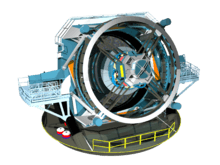 Rendering of completed LSST[1] | |
| Organisation | LSST Corporation |
|---|---|
| Location(s) | El Peñón, Chile |
| Coordinates | 30°14′40.7″S 70°44′57.9″W / 30.244639°S 70.749417°WCoordinates: 30°14′40.7″S 70°44′57.9″W / 30.244639°S 70.749417°W[2][3][5] |
| Altitude | 2,663 m (8,737 ft), top of pier[2][6] |
| Wavelength | 320–1060 nm[7] |
| Built | 2014–2019 (planned) |
| First light | 2019[8] |
| Telescope style | Three-mirror anastigmat, Paul-Baker / Mersenne-Schmidt wide-angle[9] |
| Diameter |
8.417 m (27.6 ft) physical 8.360 m (27.4 ft) optical 5.116 m (16.8 ft) inner[10][11] |
| Secondary dia. | 3.420 m (1.800 m inner)[10] |
| Tertiary dia. | 5.016 m (1.100 m inner)[10][11] |
| Angular resolution |
0.7″ median seeing limit 0.2″ pixel size[7] |
| Collecting area | 35 square metres (376.7 sq ft)[7] |
| Focal length |
10.31 m (f/1.23) overall 9.9175 m (f/1.186) primary |
| Mounting | altitude/azimuth |
| Website |
www |
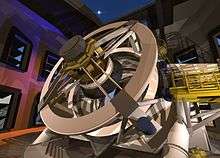
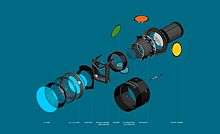
The Large Synoptic Survey Telescope (LSST) is a wide-field survey reflecting telescope with an 8.4-meter primary mirror,[10][11] currently under construction, that will photograph the entire available sky every few nights.[12] The telescope uses a novel 3-mirror design which delivers sharp images over a very wide 3.5-degree diameter field of view, feeding a 3.2-gigapixel CCD imaging camera, the largest digital camera ever constructed.[13]
The telescope will be located on the El Peñón peak of Cerro Pachón, a 2,682-meter-high mountain in Coquimbo Region, in northern Chile, alongside the existing Gemini South and Southern Astrophysical Research Telescopes.[14]
The LSST was the top-ranked large ground-based project in the 2010 Astrophysics Decadal Survey. The project officially began construction 1 August 2014 when the National Science Foundation (NSF) authorized the FY2014 portion ($27.5 million) of its construction budget.[15] The ceremonial laying of the first stone was performed on 14 April 2015.[16] Site construction began on April 14, 2015,[17] with engineering first light anticipated in 2019, science first light in 2021, and full operations for a ten-year survey commencing in January 2022.[18][19]
Overview
The LSST design is unique among large telescopes (8 m-class primary mirrors) in having a very wide field of view: 3.5 degrees in diameter, or 9.6 square degrees. For comparison, both the Sun and the Moon, as seen from Earth, are 0.5 degrees across, or 0.2 square degrees. Combined with its large aperture (and thus light-collecting ability), this will give it a spectacularly large etendue of 319 m2∙degree2.[7]
To achieve this very wide, undistorted field of view requires three mirrors, rather than the two used by most existing large telescopes: the primary mirror (M1) is 8.4 metres (28 ft) in diameter, the secondary mirror (M2) is 3.4 metres (11.2 ft) in diameter (and will be the largest convex mirror ever made), and the tertiary mirror (M3), located in a large hole in the primary, is 5.0 metres (16 ft) in diameter. The large hole reduces the primary mirror's light collecting area to 35 square metres (376.7 sq ft), equivalent to a 6.68-metre-diameter (21.9 ft) circle.[7] (Multiplying this by the field of view produces an etendue of 336 m2∙degree2; the actual figure is reduced by vignetting.)
The primary and tertiary mirrors (M1 and M3) are being constructed as a single piece of glass, the "M1M3 monolith".
A 3.2-gigapixel prime focus[note 1] digital camera will take a 15-second exposure every 20 seconds.[7] Repointing such a large telescope (including settling time) within 5 seconds requires an exceptionally short and stiff structure. This in turn implies a very small f-number, which requires very precise focusing of the camera.
The camera will include three corrector lenses to reduce aberrations; the first lens at 1.55m diameter will be the largest lens ever built. The filter will be between the second and third lens, with the third lens forming the vacuum window in front of the focal plane. The focal plane will be 64 cm in diameter, and will include 189 CCD detectors each of 16 megapixels.[20]
Allowing for maintenance, bad weather and other contingencies, the camera is expected to take over 200,000 pictures (1.28 petabytes uncompressed) per year, far more than can be reviewed by humans. Managing and effectively data mining the enormous output of the telescope is expected to be the most technically difficult part of the project.[21][22] Initial computer requirements are estimated at 100 teraflops of computing power and 15 petabytes of storage, rising as the project collects data.[23]
Scientific goals
Particular scientific goals of the LSST include:
- Measuring weak gravitational lensing in the deep sky to detect signatures of dark energy and dark matter.
- Mapping small objects in the Solar System, particularly near-Earth asteroids and Kuiper belt objects.
- Detecting transient optical events such as novae and supernovae.
- Mapping the Milky Way.
It is also hoped that the vast volume of data produced will lead to additional serendipitous discoveries.
Synoptic is derived from the Greek words σύν (syn "together") and ὄψις (opsis "view"), and describes observations that give a broad view of a subject at a particular time.
Some of the data from the LSST (up to 15 terabytes per night) will be made available by Google as an up-to-date interactive night-sky map.[24]
Construction progress
LSST construction is underway, with the NSF funding authorized as of 1 August 2014.[15]
Early development was funded by a number of small grants, with major contributions in January 2008 by software billionaires Charles Simonyi and Bill Gates of $20 and $10 million respectively.[25] $7.5 million was included in the U.S. President's FY2013 NSF budget request.[26] The Department of Energy is expected to fund construction of the digital camera component by the SLAC National Accelerator Laboratory, as part of its mission to understand dark energy.[27]
The LSST was greatly encouraged by its selection as the highest-priority ground-based instrument in the 2010 Astronomy and Astrophysics Decadal Survey.[28]
Optics
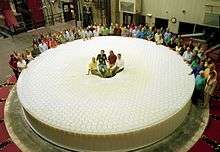
The primary mirror, the most critical and time-consuming part of a large telescope's construction, was made over a 7-year period by the University of Arizona's Steward Observatory Mirror Lab.[29] Construction of the mold began in November 2007,[30] mirror casting was begun in March 2008,[31] and the mirror blank was declared "perfect" at the beginning of September 2008.[32] In January 2011, both M1 and M3 figures had completed generation and fine grinding, and polishing had begun on M3.
The mirror was completed in December 2014.[33] The M3 portion especially suffered from tiny air bubbles which, when they broke the surface, caused "crow's feet" defects in the surface.[34] The bubbles trapped grinding abrasive, which produced scratches a few mm long radiating out from the bubble. Left as-is, these would enlarge the telescope's point spread function, reducing the sensitivity by 3% (to 97% of nominal) and increase the portion of the sky obscured by bright stars from 4% to 4.8% of the survey area. As of January 2015, the project was exploring ways to fill the holes and scratches and concluded no further polishing was necessary as the mirror surfaces exceeded the structure function requirements.
The mirror was formally accepted on 13 February 2015.[35] It was then placed in the mirror transport box and stored in an airplane hangar[36] until it is shipped to Chile.[37]
The secondary mirror was manufactured by Corning of ultra low expansion glass and coarse-ground to within 40 μm of the desired shape.[5] In November 2009, the blank was shipped to Harvard University for storage[38] until funding to complete it was available. On October 21, 2014, the secondary mirror blank was delivered from Harvard to Exelis for fine grinding.[39]
Building
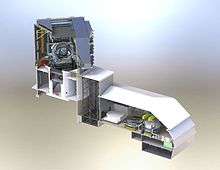
Site excavation began in earnest March 8, 2011,[40] and the site had been leveled by the end of 2011.[41] Also during that time, the design continued to evolve, with significant improvements to the mirror support system, stray-light baffles, wind screen, and calibration screen.
In 2015, a large amount of broken rock and clay was found under the site of the support building adjacent to the telescope. This caused a 6-week construction delay while it was dug out and the space filled with concrete. This did not affect the telescope proper or its dome, whose much more important foundations were examined more thoroughly during site planning.[42]
Camera
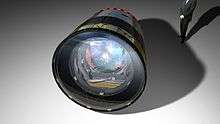
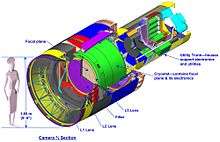

In August 2015, the LSST camera project, which is separately funded by the U.S. Department of Energy, passed its "critical decision 3" design review, with the review committee recommending DoE formally approve start of construction.[43] On August 31, the approval was given, and construction is beginning at SLAC.[44]
Notes
- ↑ The camera is actually at the tertiary focus, not the prime focus, but being located at a "trapped focus" in front of the primary mirror, the associated technical problems are similar to those of a conventional prime-focus survey camera.
See also
- List of largest optical reflecting telescopes
- Pan-STARRS
- The Dark Energy Survey
- VISTA (Visible and Infrared Survey Telescope for Astronomy)
- VLT Survey Telescope
References
- ↑ Telescope Design 2013
- 1 2 Eric E. Mamajek (2012-10-10), Accurate Geodetic Coordinates for Observatories on Cerro Tololo and Cerro Pachon, p. 13, arXiv:1210.1616
 Measured GPS position for future site of LSST pier is WGS-84 30°14′40.68″S 70°44′57.90″W / 30.2446333°S 70.7494167°W, with ±0.10″ uncertainty in each coordinate.
Measured GPS position for future site of LSST pier is WGS-84 30°14′40.68″S 70°44′57.90″W / 30.2446333°S 70.7494167°W, with ±0.10″ uncertainty in each coordinate. - ↑ Charles F. Claver; et al. (2007-03-19), LSST Reference Design (PDF), LSST Corporation, pp. 64–65, archived (PDF) from the original on 2015-04-08, retrieved 2008-12-10 The map on p. 64 shows the Universal Transverse Mercator location of the centre of the telescope pier at approximately 6653188.9 N, 331859.5 E, in zone 19J. Assuming the PSAD56 (La Canoa) datum, widely used in South America,[4] this translates to WGS84 30°14′39.6″S 70°44′57.8″W / 30.244333°S 70.749389°W. Other datums do not lead to a peak.
- ↑ Mugnier, C.P., C.M.S., Clifford J. (January 2007), "Grids & Datums: Republic of Chile" (PDF), Photogrammetric Engineering & Remote Sensing, 73 (1): 11, retrieved 2015-08-08
- 1 2 Victor Krabbendam; et al. (2011-01-11). "LSST Telescope and Optics Status" (PDF). American Astronomical Society 217th Meeting (poster). Seattle, Washington. Retrieved 2015-08-05. This updated plan shows the revised telescope centre at 6653188.0 N, 331859.1 E (PSAD56 datum). This is the same WGS84 location to the resolution shown.
- ↑ LSST Summit Facilities, 2009-08-14, retrieved 2015-08-05
- 1 2 3 4 5 6 LSST System & Survey Key Numbers, LSST Corporation, retrieved 2015-08-05
- ↑ Jacoby, Suzanne (2014-08-04). "AURA's Large Synoptic Survey Telescope to Begin Construction, Thanks to National Science Foundation Funding Support" (Press release). Texas A&M University.
- ↑ Willstrop, Roderick V. (October 1, 1984), "The Mersenne-Schmidt: A three-mirror survey telescope", Monthly Notices of the Royal Astronomical Society, 210 (3): 597–609, Bibcode:1984MNRAS.210..597W, doi:10.1093/mnras/210.3.597, ISSN 0035-8711, retrieved 2015-08-05
- 1 2 3 4 Gressler, William (June 2, 2009), LSST Optical Design Summary (PDF), LSE-11, archived from the original (PDF) on 2012-03-20, retrieved 2011-03-01
- 1 2 3 Tuell, Michael T.; Martina, Hubert M.; Burge, James H.; Gressler, William J.; Zhao, Chunyu (July 22, 2010), "Optical testing of the LSST combined primary/tertiary mirror" (PDF), Proc. SPIE 7739, Modern Technologies in Space- and Ground-based Telescopes and Instrumentation (77392V), doi:10.1117/12.857358
- ↑ LSST General Public FAQs
- ↑ "Camera". LSST. Retrieved August 2015. Check date values in:
|access-date=(help) - ↑ "Press Release LSSTC-04: Site in Northern Chile Selected for Large Synoptic Survey Telescope" (PDF). LSST. 17 May 2006. Retrieved August 2015. Check date values in:
|access-date=(help) - 1 2 Kahn, Steven; Krabbendam, Victor (August 2014). "LSST Construction Authorization" (Press release). Lsst Corp.
- ↑ "LSST First Stone" (Press release). LSST Corporation. 14 April 2015.
- ↑ "The Large Synoptic Survey Telescope: Unlocking the secrets of dark matter and dark energy". Phys.org. May 29, 2015. Retrieved 3 June 2015.
- ↑ LSST Project Schedule
- ↑ Krabbendam, Victor (2012-08-13), "LSST Project and Technical Overview" (PDF), LSST All Hands Meeting, Tucson, Arizona
- ↑ "Technical Details". Large Synoptic Survey Telescope. Retrieved March 2016. Check date values in:
|access-date=(help) - ↑ Matt Stephens (2008-10-03), Mapping the universe at 30 Terabytes a night: Jeff Kantor, on building and managing a 150 Petabyte database, The Register, retrieved 2008-10-03
- ↑ Matt Stephens (2010-11-26), Petabyte-chomping big sky telescope sucks down baby code, The Register, retrieved 2011-01-16
- ↑ Boon, Miriam (2010-10-18), "Astronomical Computing", Symmetry Breaking, retrieved 2010-10-26
- ↑ "Google Joins Large Synoptic Survey Telescope (LSST) Project". uanews.org. January 10, 2007. Retrieved 29 April 2013.
- ↑ Dennis Overbye (January 3, 2008). "Donors Bring Big Telescope a Step Closer". The New York Times. Retrieved 2008-01-03.
- ↑ "LSST Project Office Update". March 2012. Retrieved 2012-04-07.
- ↑ "World's largest digital camera gets green light". 2011-11-08. Retrieved 2012-04-07./
- ↑ "Large Synoptic Survey Telescope gets Top Ranking, "a Treasure Trove of Discovery"" (PDF) (Press release). LSST Corporation. 2010-08-16. Retrieved 2015-08-05.
- ↑ Steward Observatory Mirror Lab Awarded Contract for Large Synoptic Survey Telescope Mirror
- ↑ Inage Gallery: Mirror Fabrication
- ↑ LSST High Fire Event
- ↑ Giant Furnace Opens to Reveal 'Perfect' LSST Mirror Blank (PDF), LSST Corporation, 2009-09-02, retrieved 2011-01-16
- ↑ LSST.org (December 2014). "LSST E-News - Volume 7 Number 4". Retrieved 2014-12-06.
- ↑ Gressler, William (15 January 2015). Telescope and Site Status (PDF). AURA Management Council for LSST. pp. 8–13. Retrieved 2015-08-11.
- ↑ LSST.org (April 2015). "M1M3 Milestone Achieved". LSST E-News. Retrieved 2015-05-04.
- ↑ Beal, Tom (28 February 2015). "Big mirror about to move from UA lab". Arizona Daily Star. Retrieved 2015-05-04.
- ↑ Jepsen, Kathryn (January 12, 2015). "Mirror, mirror: After more than six years of grinding and polishing, the first-ever dual-surface mirror for a major telescope is complete". Symmetry. Retrieved 2015-02-01.
- ↑ "LSST M2 Substrate Complete and Shipped", LSST E-News, 2 (4), January 2010
- ↑ "LSST M2 Substrate Received by Exelis", LSST E-News, 7 (4), December 2014
- ↑ Kaboom! Life’s a Blast on Cerro Pachón, LSST Corporation, April 2011, retrieved 2015-08-05
- ↑ Victor Krabbendam; et al. (2012-01-09). "Developments in Telescope and Site" (PDF). American Astronomical Society 219th Meeting (poster). Austin, Texas. Retrieved 2012-01-16.
- ↑ "Excavation Activities on Cerro Pachón", LSST E-News, 8 (2), August 2015
- ↑ "LSST Camera Team Passes DOE CD-3 Review". 10 August 2015. Retrieved 2015-08-11.
- ↑ "World's Most Powerful Digital Camera Sees Construction Green Light" (Press release). SLAC. 31 August 2015.
External links
| Wikimedia Commons has media related to Large Synoptic Survey Telescope. |
- Official home page
- LSST construction site webcams
- LSST reports and documentation
- New Scientist SPACE Article
- LSST Tutorials for Experimental Particle Physicists is a detailed explanation of LSST's design (as of February 2006) and weak lensing science goals that does not assume a lot of astronomy background.
- The New Digital Sky is a video of a July 25, 2006 presentation at Google about the LSST, particularly the data management issues.
- HULIQ Google participation announcement
- Ž. Ivezić; et al. (2008-05-15), LSST: From Science Drivers to Reference Design and Anticipated Data Products (v1.0), 0805, p. 2366, arXiv:0805.2366
 , Bibcode:2008arXiv0805.2366I, retrieved 2015-08-05, this is a comprehensive overview of the LSST.
, Bibcode:2008arXiv0805.2366I, retrieved 2015-08-05, this is a comprehensive overview of the LSST. - LSST Science Collaborations; Abell, Paul A.; Allison, Julius; Anderson, Scott F.; Andrew, John R.; Angel, J. Roger P.; Armus, Lee; Arnett, David; Asztalos, S. J. (2009-10-16), LSST Science Book, Version 2.0, 0912, p. 201, arXiv:0912.0201
 , Bibcode:2009arXiv0912.0201L, retrieved 2011-01-16, an updated and expanded overview.
, Bibcode:2009arXiv0912.0201L, retrieved 2011-01-16, an updated and expanded overview.